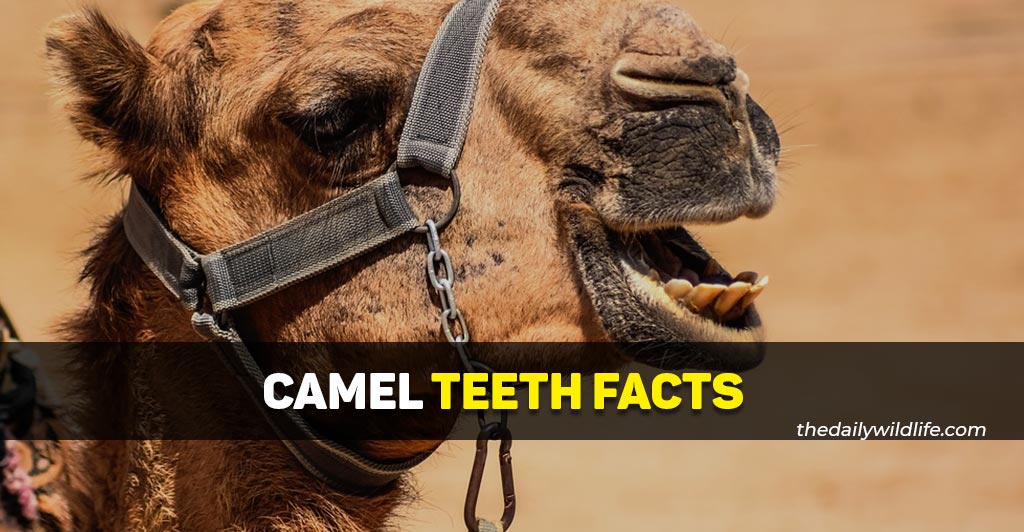Camel’s mouths are some of the most fascinating organs.
Someone once described them as a Sarlacc pit from Star Wars.
One part of that scary pit is certainly its teeth.
Here are 7 fascinating facts about camel teeth.

Camel Teeth Facts
1. A Camel Has 22 Milk And 34 Permanent Teeth
Similar to other mammals, camels are born without teeth and will first grow deciduous (temporary milk) teeth.
A camel has three types of teeth:
- Incisor (front) teeth
- Canine (fang) teeth
- Molar (side) teeth – premolar teeth in baby camels
Milk teeth in the upper jaw are organized as follows:
- One incisor tooth on each side (2 in total)
- One canine tooth on each side (2 in total)
- Three cheek teeth on each side (6 in total)
Milk teeth in the lower jaw:
- Three front teeth on each side (6 in total)
- One canine tooth on each side (2 in total)
- Two cheek teeth on each side (4 in total)
As they mature, they will slowly replace them with stronger, permanent teeth.
Permanent teeth in the upper jaw:
- One front tooth on each side (2 in total)
- One canine tooth on each side (2 in total)
- Six cheek teeth on each side (12 in total)
Permanent teeth in the lower jaw:
- Three front teeth on each side (6 in total)
- One canine tooth on each side (2 in total)
- Five cheek teeth on each side (10 in total)
When talking in the context of the upper jaw, canine teeth might be considered camel fangs.
2. Camels Also Have A Pair Of Canine (Dog Teeth) In Their Upper And Lower Jaw
Permanent canine teeth appear at the age of 6 and can grow up to 1.5 inches long (4 cm) by the age of 7. These sharp teeth are used to crush woody plants for food.
Some owners may decide to cut canines in the lower jaw.
3. Camel Teeth Can Be Used To Age A Camel
The teeth that are mostly used for that are the incisors (front teeth), the canines, and the first premolars.
For example, when born, a calf will have no teeth. By the 9th month, it will have all of the milk teeth.
Around the age of 4, a camel will have its milk incisors and canine worn down and start getting replaced by permanent teeth.
Camels that are around the age of 7 have all the permanent incisors and canine teeth.
4. As Camel Ages, Its Teeth Will Wear Off
After the teeth have fully developed, they will begin to wear off.
One study has discovered that incisor (front) teeth of camels between the ages of 9-11 and canine teeth around the age of 12 will begin to wear off in Moroccan camels.
However, in Sudanese and Egyptian camels, that teeth degradation can appear a bit later (at 9, 10½, 12, and 15 years respectively). [1]
By the age of 20, all the permanent teeth will be visibly worn down and clearly separated from one other.
5. A Camel’s Teeth Might Wear Off Faster Because Of Its Nutrition
The same study speculated that teeth may diminish because of the type of food a camel has been fed.
Camels that were given rougher hard leaves, thorny plants, and shrubs might have their teeth wear off faster than those that were fed with softer foods like hay, grass, and leftovers.
Other factors that influence camel teeth decay are sex, breed, camel’s environment, genetics, etc.
6. Camel’s Durable Teeth And Mouth Allow It To Chew A Full Cactus
At the top of their mouths, camels have a tough palate. Camel’s teeth grind food against this palate.
Another thing in their mouths is a long, cone-shaped, and hardened structure called the papilla.
Camel has lots of papillae in their mouths that allow it to chew thorny plants like cactuses.
The camel’s rotating chew distributes pressure from the cactus and the papillae orient the spines of the cactus vertically so they do not hurt the throat.
7. Camel’s Strong Bite Can Cause Serious Injuries
Their large teeth and strong jaw musculature can generate a biting force of almost 400 pounds per square inch (28 kg per square cm).
As a comparison, a human’s jaw bite force is around 200 Psi.
Their canine knife-sharp teeth will cause small injuries on the surface, but deep structures can be seriously wounded.
A 6-year long study in the United Arab Emirates found that out of 33 patients admitted to hospital with camel injuries, 26 were bitten. [2]
Most bites were in the upper limb (64%) and head and face (15%), and most of the injuries (73%) happened during a mating season of camels when they are known to be hard to handle.
Even though camels are most of the time timid and friendly, you should always be cautious around them.
Final thoughts
And there you have it, 7 interesting camel teeth facts!
Camels have 22 milk and 34 permanent teeth. They also have 2 pairs of canine teeth in their jaws that allow them to eat branches, but can also cause injuries to humans. Their teeth and mouth allow them to chew a full cactus. As the camel ages, its teeth will deteriorate and get separated.
References
[1] Bello, A., et al. “Age estimation of camel in Nigeria using rostral dentition.” (2013).
[2] Abu-Zidan, Fikri M., et al. “Camel bite injuries in the United Arab Emirates: a 6-year prospective study.” Injury 43.9 (2012): 1617-1620.